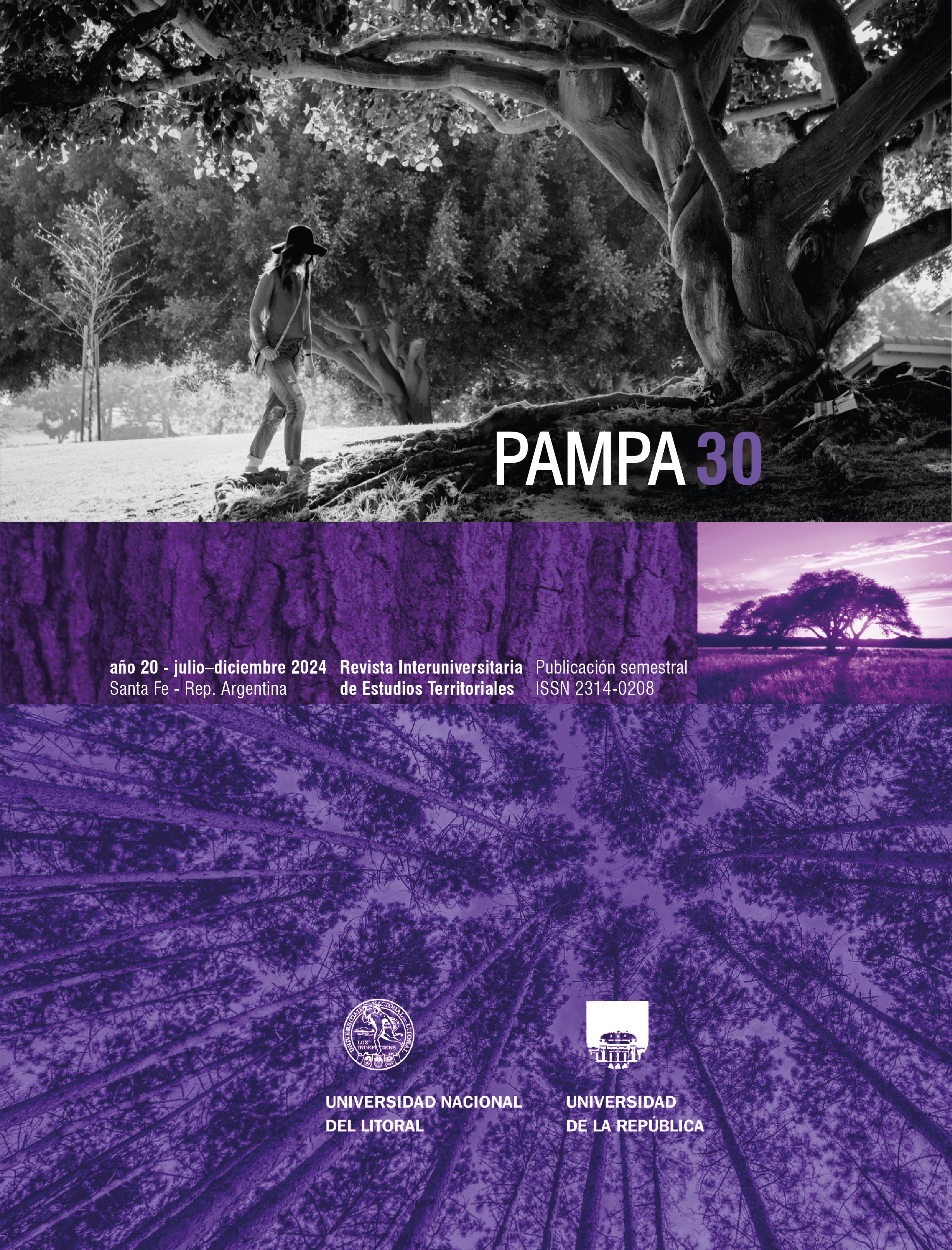Explorando redes de simbiosis industrial: sinergias impulsadas por el bioetanol
DOI:
https://doi.org/10.14409/pampa.2024.30.e0089Palabras clave:
Bioetanol, Simbiosis industrial, Residuos Agroindustriales, SubproductosResumen
Este trabajo se enfoca en explorar las redes de Simbiosis Industrial originadas por el bioetanol de maíz en la provincia de Córdoba, Argentina, con el fin último de contribuir al conocimiento de este fenómeno y a los factores que lo impulsan, para el aprovechamiento de los residuos y subproductos de la agroindustria. Se realizaron 16 entrevistas a propietarios o gerentes de plantas de bioetanol, de biogás, de feedlots, productores de alimentos y productores de gas carbónico. Se encontraron dos grandes redes de simbiosis industrial, con 28 intercambios de residuos y subproductos a los que se les agrega valor y son materias primas de otras organizaciones. Este trabajo amplía el conocimiento sobre la implementación y los efectos positivos de la simbiosis industrial, particularmente los beneficios en términos de triple impacto (económico-social-ambiental) y las ventajas competitivas asociadas para el sector industrial. Se encontró que es clave para el desarrollo de una red de simbiosis la apertura a la colaboración de las organizaciones que son parte.
Citas
Abriat y Masut. (2021). Simbiosis Industrial en empresas y su impacto en el empleo. Organización Internacional de Trabajo. Recuperado de: https://www.ilo.org/wcmsp5/groups/public/---americas/---ro-lima/---ilo buenos_aires/documents/publication/wcms_803622.pdf
Bijon, N., Wassenaar, T., Junqua, G., y Dechesne, M. (2022). Towards a sustainable bioeconomy through industrial symbiosis: Current situation and perspectives. Sustainability, 14(3), 1605. https://doi.org/10.3390/su14031605
Bio 4 (2024) Proyecto Huerta Sustentable. Desarrollo de valor social. Página oficial de Bio4. Recuperado de: https://www.bio4.com.ar/proyecto-huerta-sustentable desarrollo-valor-social/
Buraschi, M. (2021) Gobernanza de la sustentabilidad: upgrading económico, social y ambiental en la cadena de valor del biodiésel argentino. Tesis doctoral. Córdoba: Universidad Nacional de Córdoba
Chertow, M. R. (2000). Industrial symbiosis: literature and taxonomy. Annual review of energy and the environment, 25(1), 313-337. https://doi.org/10.1146/annurev.energy.25.1.313
Chertow, M. R. (2007). “Uncovering” industrial symbiosis. Journal of industrial Ecology, 11(1), 11-30.https://doi.org/10.1162/jiec.2007.1110
Chertow, M., y Ehrenfeld, J. (2012). Organizing self‐organizing systems: Toward a theory of industrial symbiosis. Journal of industrial ecology, 16(1), 13-27. https://doi.org/10.1111/j.1530-9290.2011.00450.x
Chertow, M., y Miyata, Y. (2011). Assessing collective firm behavior: Comparing industrial symbiosis with possible alternatives for individual companies in Oahu, HI. Business Strategy and the Environment, 20(4), 266-280. https://doi.org/10.1002/bse.694
Colwill, J.; Wright, E. I.; Rahimifard, S. y Clegg, A. (2012). “Bio-plastics in the context of competing demands on agricultural land in 2050”. International Journal of Sustainable Engineering, 5(1): 3-16. https://doi.org/10.1080/19397038.2011.602439
Domenech T., Bleischwitz R., Doranova A., Panayotopoulos D., y Roman L (2019) Mapping industrial symbiosis development in Europe, typologies of networks, characteristics, performance and contribution to the Circular Economy. Resources, conservation and recycling (141) 76–98.
Dong, L., Fujita, T., Zhang, H., Dai, M., Fujii, M., Ohnishi, S., y Liu, Z. (2013). Promoting low-carbon city through industrial symbiosis: A case in China by applying HPIMO model. Energy policy, (61) 864-873.https://doi.org/10.1111/j.1530-9290.2011.00444.x
Freitas, L. A., y Magrini, A. (2017). Waste management in industrial construction: Investigating contributions from industrial ecology. Sustainability, 9(7), 1251. https://doi.org/10.3390/su9071251
FAO (2020) The state of food and agriculture 2020. Overcoming water challenges in agriculture. Food and Agriculture Organizations of the United Nations https://doi.org/10.4060/cb1447en
Frosch, R. A., y Gallopoulos, N. E. (1989). Strategies for manufacturing. Scientific American, 261(3), 144-153.
IICA (2019) Programa de bioeconomía y desarrollo productivo. Instituto Interamericano de Cooperación para la Agricultura. Recuperado de: https://repositorio.iica.int/handle/11324/7909
IICA (2021) Potencial de la bioeconomía para la transformación de los sistemas alimentarios. Instituto Interamericano de Cooperación para la Agricultura. Recuperado de: https://repositorio.iica.int/handle/11324/18564
Lombardi, D. R., y Laybourn, P. (2012). Redefining industrial symbiosis: Crossing academic– practitioner boundaries. Journal of Industrial Ecology, 16(1), 28-37. https://doi.org/10.1111/j.1530-9290.2011.00444.x
Harchaoui, S., y Chatzimpiros, P. (2019). Energy, Nitrogen, and Farm Surplus Transitions in Agriculture from Historical Data Modeling. France, 1882–2013. Journal of Industrial Ecology, 23(2), 412-425. https://doi.org/10.1111/jiec.12760
Hein, A. M., Jankovic, M., Feng, W., Farel, R., Yune, J. H., y Yannou, B. (2017). Stakeholder power in industrial symbioses: A stakeholder value network approach. Journal of Cleaner Production, (148) 923-933.
Herczeg, G., Akkerman, R., y Hauschild, M. Z. (2018). Supply chain collaboration in industrial symbiosis networks. Journal of Cleaner Production, (171), 1058-1067. https://doi.org/10.1016/j.jclepro.2017.10.046
Kalundborg Symbiosis (2024) About Us. Surplus from circular production. Página oficial de Kalundborg Symbiosis. Recuperado de: https://www.symbiosis.dk/en/om-os/
Koppelmäki, K., Helenius, J., & Schulte, R. P. (2021). Nested circularity in food systems: a Nordic case study on connecting biomass, nutrient and energy flows from field scale to continent. Resources, Conservation and Recycling, 164, 105218. https://doi.org/10.1016/j.resconrec.2020.105218
Martin, M., y Eklund, M. (2011). Improving the environmental performance of biofuels with industrial symbiosis. Biomass and Bioenergy, 35(5), 1747-1755. https://doi.org/10.1016/j.biombioe.2011.01.016
Martin, M., y Harris, S. (2018). Prospecting the sustainability implications of an emerging industrial symbiosis network. Resources, Conservation and Recycling, 138, 246-256. https://doi.org/10.1016/j.resconrec.2018.07.026
Martínez Carazo, P. C. (2006). El método de estudio de caso como estrategia metodológica de la investigación científica. Pensamiento y Gestión, 20, 165-193.
Miller GT. 1994. Living in the Environment. Belmont, CA: Wadsworth. 8th ed.
Mirata, M. (2004). Experiences from early stages of a national industrial symbiosis programme in the UK: determinants and coordination challenges. Journal of Cleaner production, 12(8-10), 967-983. https://doi.org/10.1016/j.jclepro.2004.02.031
Mortensen, L. y Kornov, L. (2019). Critical factors for industrial symbiosis emergence process. Journal of cleaner production, (212) 56-69.
Neves, A., Godina, R., Azevedo, S. G., y Matias, J. C. (2020). A comprehensive review of industrial symbiosis. Journal of cleaner production, 247, 119113. https://doi.org/10.1016/j.jclepro.2019.119113
Rios y Rodríguez (2021) Las Redes de Simbiosis Industrial y el Empleo, el caso Colombiano. Organización Internacional de Trabajo. Recuperado de:
https://www.ilo.org/wcmsp5/groups/public/---americas/---ro-lima/---sro lima/documents/publication/wcms_777897.pdf
Secretaría de energía (en línea). Datos de energías renovables – plantas de biocombustibles.http://datos.minem.gob.ar/dataset/energias-renovables-plantas biocombustibles
Sherwood, J. (2020) The significance of biomass in a circular economy. Bioresource Technology, (300) 122755. https://doi.org/10.1016/j.biortech.2020.122755
Short, S. W., Bocken, N. M. P., Barlow, C. Y., y Chertow, M. R. (2014). From refining sugar to growing tomatoes: Industrial ecology and business model evolution. Journal of Industrial Ecology, 18(5), 603–618. https://doi.org/10.1111/jiec.12171
Stake, R. (2005). Qualitative case studies (pp 443-466). En N. Denzin, y Y. Lincoln, The Sage Handbook of Qualitative Research. Thousand Oaks: Sage
Teng, Y., Mao, C., Liu, G., y Wang, X. (2017). Analysis of stakeholder relationships in the industry chain of industrialized building in China. Journal of Cleaner Production, (152) 387-398.
Torroba, A. (2021). Biocombustibles líquidos: institucionalidad y formulación de políticas públicas. Instituto Interamericano de Cooperación para la Agricultura (IICA).
USDA (2022). Biofuels Annual Report: Argentina. United States Department of Agriculture Disponible en: https://www.fas.usda.gov/data/argentina-biofuels-annual-7
Vea, E.B., Romeo, D., y Thomsen, M., (2018) Biowaste Valorisation in a Future Circular Bioeconomy. Procedia CIRP. (69) 591–596. https://doi.org/10.1016/j.procir.2017.11.062
Velenturf, A. P. (2016). Promoting industrial symbiosis: empirical observations of low-carbon innovations in the Humber region, UK. Journal of Cleaner Production, 128, 116-130. https://doi.org/10.1016/j.jclepro.2015.06.027
Yin, R. (2009). Case Study Research – Design and Methods (4th Ed.). SAGE Publications: Thousand Oaks, CA.
Yu F., Han F., y Cui Z. (2015) Evolution of industrial symbiosis in an eco-industrial park in China. Journal of Cleaner Production (87) 339–347.
Publicado
Cómo citar
Número
Sección
Licencia
Derechos de autor 2024 Pampa

Esta obra está bajo una licencia internacional Creative Commons Atribución-NoComercial-CompartirIgual 4.0.


















